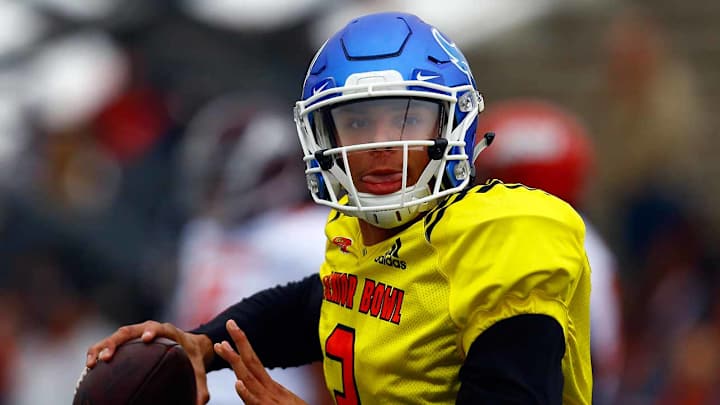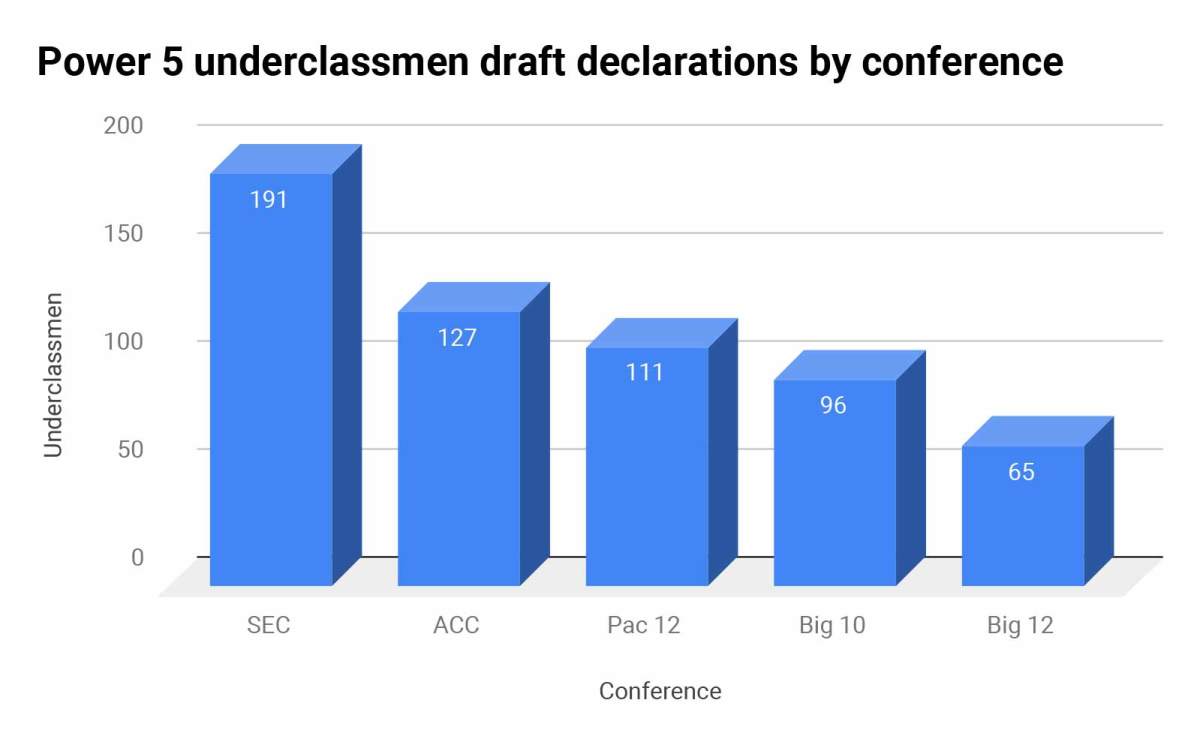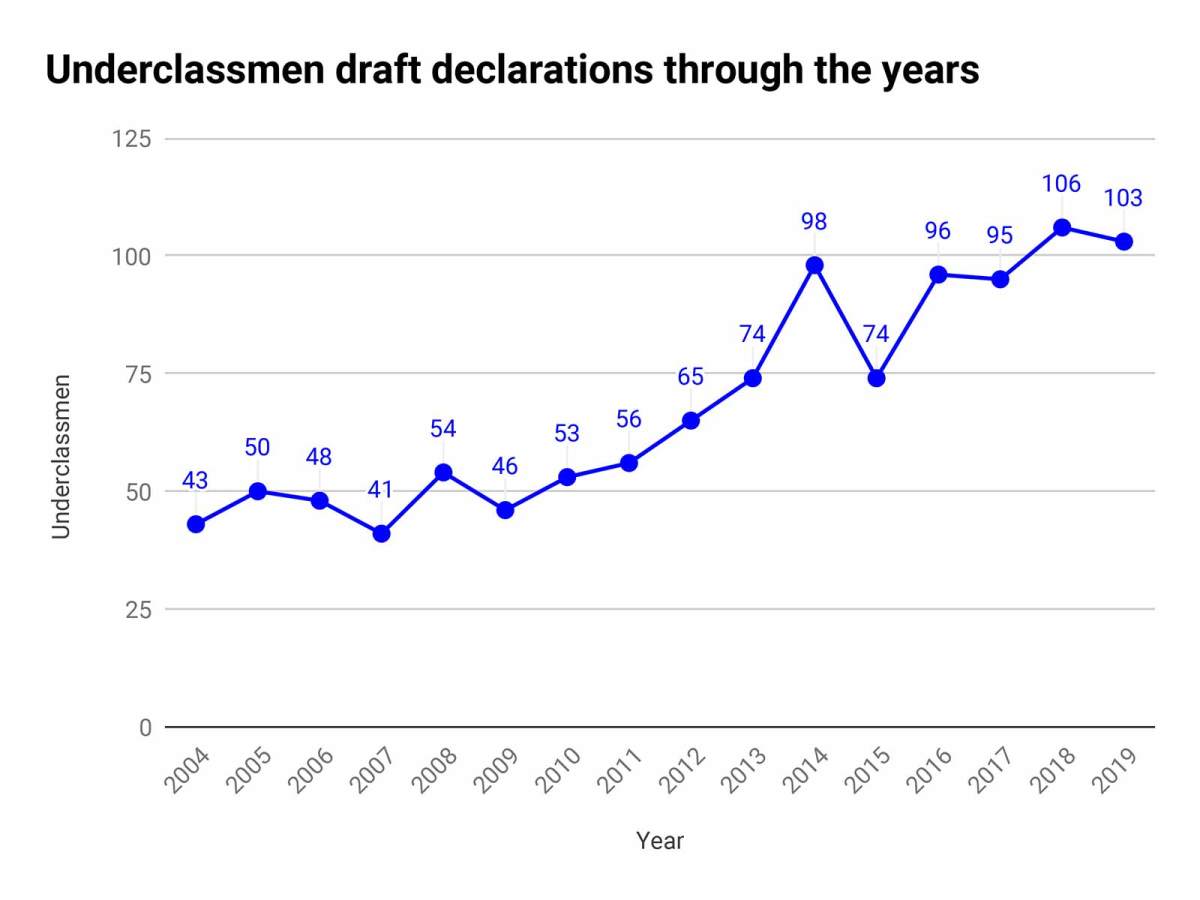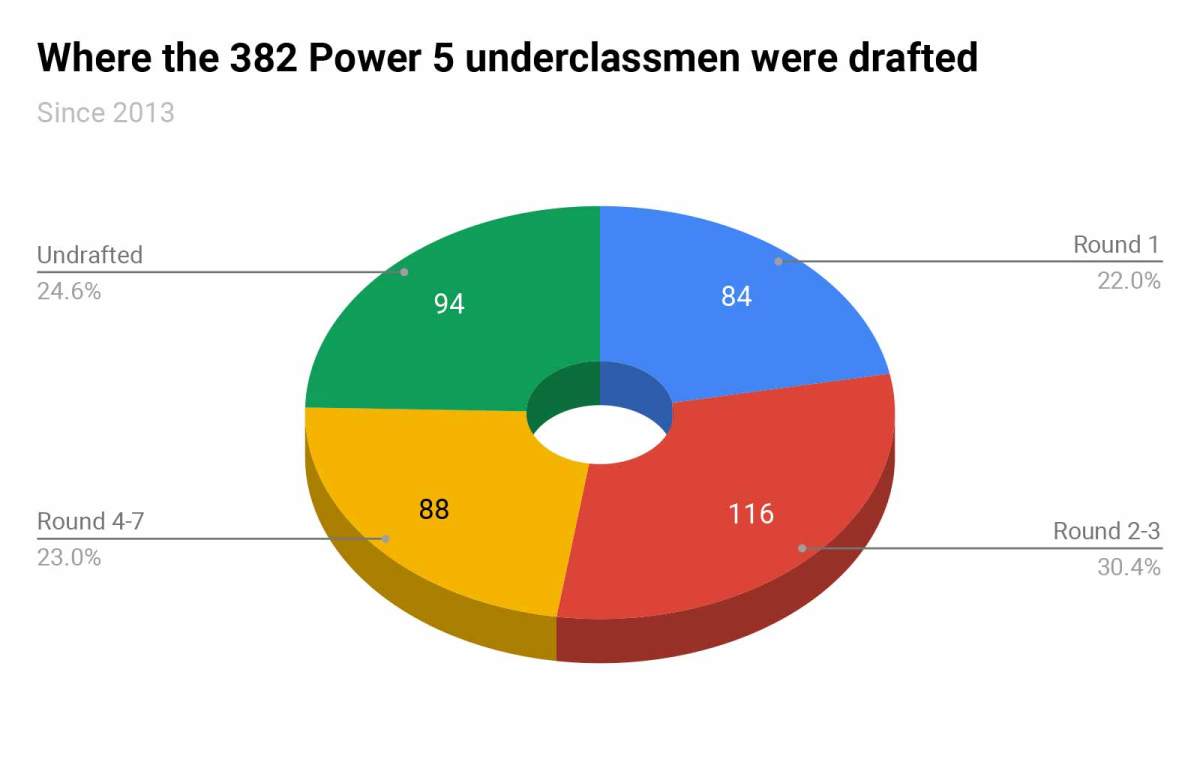The NFL Draft Machine Is Still Adjusting to the Flood of Underclassmen Going Pro Early

MOBILE, Ala. — As one of the last invitees to the Senior Bowl, Anthony Nelson is more excited to be here than most. As recently as a week ago, the 6'7" Iowa defensive end would have never expected to receive an invitation to the premier college all-star game. Having just finished his redshirt junior season, Nelson didn’t even realize he was eligible for an event with “Senior” in its name. “I didn’t know that was a thing,” he said earlier this week. “It changed my plans real quick.”
Nelson is one of 11 fourth-year juniors participating this week at the Senior Bowl. You probably recognize the names of a few others: Auburn quarterback Jarrett Stidham, Buffalo quarterback Tyree Jackson, Memphis running back Tony Pollard and Duke quarterback Daniel Jones are part of the largest non-senior class of players at this event since it loosened its eligibility qualifications. The Senior Bowl is only keeping up with the times, tweaking its criteria to conform to the broader trend of players looking to leave for the pros before their college eligibility is maxed out.
This year, a record 135 underclassmen declared for the draft. Thirty-two of those prospects did not need special eligibility from the NFL to enter the draft because they had already graduated, but the other 103 did. The 400 early declarations over the past four draft classes dwarf the total of 189 players who came out early a decade ago (for the 2006–09 drafts), and for the first time in college football history, more than 100 underclassmen left school early in consecutive years. As college seniors began to make up a smaller percentage of each draft pool’s top talents, former Senior Bowl executive director Phil Savage opened the event to fourth-year juniors who declared for the draft, with the strict requirement that they graduate by December. The Senior Bowl isn’t so senior any longer. This year, 9.6% of the 114 participants skipped their final year of college eligibility. New executive director Jim Nagy, a former NFL scout in his first year replacing Savage, expects that percentage to rise in the future. Nagy is not putting a limit on invitations to redshirt juniors. “They’ve worked so hard and graduated,” Nagy said. “Why should they be penalized for being a junior when they’ve got their diploma in hand?”
Nagy feels like he’s doing the NFL a “favor” by inviting some non-seniors. Scouts and executives used to be relatively unfamiliar with players who declared early; now, NFL teams know to identify future underclassman entrants as quickly as they can. Nagy is doing the same with his event in mind. For instance, this summer he pinpointed Duke’s Jones as a potential early declaration, then revealed to the quarterback that he’d be eligible for the Senior Bowl if he added one class to his academic schedule last fall. He did it, graduated in December and is here in Mobile with a chance to play his way into being the first quarterback off the board in late April.

Jones’s decision to leave college is likely to end well, but that’s not always the case for those who depart from school early. More than 380 underclassmen from Power 5 schools have turned pro since 2013, and 94 of them (24%) did not get drafted. The departures are highest in the SEC, a league that prides itself in signing blue-chip players from football-crazed parts of the country. Three of the top four programs in underclassman departures are from the SEC, and the league has lost a whopping 190 players early to the pros over the last seven years, 63 more than the league with the next-highest total, the ACC (127).
LSU leads the nation with 35 underclassmen declaring over that seven-year stretch, followed by Florida (28), Alabama (27) and Ohio State (26). Rounding out the top 10 are Florida State (25), Clemson (24), USC and Oklahoma (19 each) and Stanford and Notre Dame (18). These bluebloods sign the nation’s most talented high school football players, win with them and watch many of them become NFL-ready within a span of three years. That doesn’t always mean they should leave. “There are too many kids that declare every year,” says Bleacher Report draft analyst Matt Miller.

The reasons for this trend vary widely, according to experts and players. Those from poor financial situations are chasing paychecks. Others receive inaccurate information on their draft projections, from whispering agents or associates steering them wrong. “Players search their name on Twitter and see some dude with a draft handle say they’re a first rounder and they believe it, or an agent tells them they’re great,” Miller says.
Another group arrives to college determined to turn pro after year three. “I think guys have their minds made up coming out of high school,” says former Alabama center Ross Pierschbacher. “It’s the cool thing to do, be three-and-out.”
Derrick Ansley, a former Alabama assistant, is coaching the North team at the Senior Bowl as part of the Oakland Raiders’ staff. He believes the accelerated maturation of high school athletes is behind the movement. A growing number of top recruits are graduating high school a semester early to enter college in January, so many of them arrive at their fall camp more athletically and mentally prepared to contribute than ever. “Guys are coming in more ready to play,” Ansley says. “The kids are bigger, stronger and faster, but they’re also getting to campus sooner.”
No matter the reason, the trend does not show signs of slowing. Florida and Alabama tied for the most non-seniors turning pro this year with five, but several big programs are only beginning to feel the effects of early departures. Four Michigan underclassmen went pro this year, one more than the program’s total from 2013 to ’18. Iowa had three underclassmen leave, the same total that left in the previous six years combined. Georgia had four leave after a combined eight left the last six years.
Frequent departures of underclassmen can be devastating to the depth of a college football team. Just ask LSU. From 2012 to ’15, the Tigers lost 24 non-seniors, the equivalent of an entire recruiting class, to the draft. The program went 20–12 in SEC play over those years and then fired longtime coach Les Miles in ’16. The Tigers still holds what is believed to be the record for underclassman departures in a single year at 11 (2013). Former LSU coaches admit and current players confirm that previous staff members used a three-years-and-out pitch in recruiting, promising to have highly touted prospects ready to launch into the NFL after their junior seasons.
Ed Orgeron is attempting to slow the exodus. The school has started using consultants to help educate juniors on their projections. Three underclassmen left LSU early this year, after six did last year and four the year before. Tight end Foster Moreau, a senior and team captain who is competing at the Senior Bowl, says things are changing in Baton Rouge. “The culture is getting close, getting close to where guys want to stay, want to be seniors, leave a legacy and help build a culture Coach O is trying to instill in the team,” he says. “Guys are just compelled to stay. It starts with just one guy who should leave and he stays. ‘Well, he’s staying, I’m staying.’ ‘He’s leaving, I might leave.’”

LSU’s hit rate of departing underclassmen is slightly higher than the Power 5 average. Of the program’s 32 early entrants since 2013, 19 (59%) were picked in the first through third rounds and just six went undrafted. On the Power 5 level, 52% of early entrants were picked by the third round. “It’s crazy watching guys leave early and not get drafted,” says Cameron Smith, USC’s former all-Pac 12 linebacker who decided against leaving early last year and is participating in the Senior Bowl this week. “Was it worth it? I was in that predicament last year. Why not guarantee myself for another year of football for sure?”
Some believe the NFL’s mid-January deadline for declaring for the draft is far too soon for prospects to make an educated decision. A few former players believe the NFL should adopt the NBA’s policy. Basketball players who do not hire an agent can declare for the draft, go through the evaluation process and then, 10 days before the draft, withdraw to return to college. “Players are asked to make decisions way too early in the process,” Miller said earlier this week. “A player’s stock is mostly affected from Jan. 1 until [the draft].” Savage suggests pushing back the January deadline and creating a “junior showcase,” providing players a multi-day workout in front of scouts before they make their NFL decisions. “I think as a sport in general, there has to be a way to educate underclassmen and their families more than what’s being done on a school-by-school basis,” Savage says.
Savage is now the general manager for the Arizona Hotshots of the Alliance of American Football, far removed from the sometimes frustrating days of filling the Senior Bowl roster. Nagy admitted this week the difficulty in finding enough draftable running backs because “a lot of the good ones leave as [third-year] juniors.” The same goes for his efforts to invite players from Alabama and Auburn, the in-state powers that send their blue-chip talent to the pros each year. “It’s getting harder and harder,” Nagy says. Receiver and cornerback were traditionally the other difficult positions to fill out, Savage says.
For now, Nagy must expand on the practice that Savage began years ago, but he doesn’t mind that challenge. It’s a byproduct of a larger movement in college football that no one expects to slow down. “If anything, it increases,” Savage says. He expects the trend of draft-bound juniors skipping bowl games to leak deeper into the regular season, as everyone’s eyes turn to the NFL earlier. “Where is the line? End of October if a team isn’t doing well? End of September? I wonder where that trend stops,” he says.
Savage is among the group that believes another set of juniors will begin passing on their senior seasons: high school juniors who are afraid of jeopardizing their early scholarship offers. That’s a complicated issue for another day. Meanwhile, the early departure trend in college football has found its way to the Senior Bowl, where players with college eligibility remaining are milling about with those who have exhausted it. And as to whether even more juniors will descend on Mobile in the future, Nagy smiles: “I don’t see why not.”
